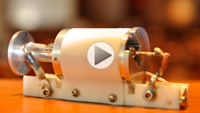BELLINGHAM, Washington, USA -- Laser technology was celebrated with a rare firing of the first working laser at a conference in Vancouver, Canada, last weekend honoring its inventor, Theodore Maiman, and with other observances of the technology's golden anniversary.
At Simon Fraser Univ. in Vancouver, Dan Gelbart, a Univ. of British Columbia professor and inventor, had the honor of activating the ruby laser that Maiman built 50 years ago at Hughes Research Labs in Malibu, California. The invention was the first demonstration of an idea about the absorption and emission of radiation that Albert Einstein characterized as a "splendid light" when he envisioned it in 1916. (Click on the arrow in the laser photo at right to see video of the refiring of the original laser.)
(Click on the arrow in the laser photo at right to see video of the refiring of the original laser.)
An international panel of speakers including SPIE CEO Eugene Arthurs paid tribute to Maiman's vision and perseverance. Maiman's wife, Kathleen, helped organize the conference at SFU, where he taught before his death in 2007.
Speakers noted that the first laser was greeted with mixed understanding, with references such as "death ray" appearing in popular press reports and its characterization as "a solution in search of a problem." But an avalanche of applications in healthcare, security, entertainment, and numerous other areas followed. Edward Moses of the National Ignition Facility at Lawrence Livermore (California) National Lab noted that just three days after the announcement of Maiman's laser, John Nuckolls proposed using the laser to create fusion. The powerful laser array at NIF is now working on creating a clean energy source using fusion.
Edward Moses of the National Ignition Facility at Lawrence Livermore (California) National Lab noted that just three days after the announcement of Maiman's laser, John Nuckolls proposed using the laser to create fusion. The powerful laser array at NIF is now working on creating a clean energy source using fusion.
A weekend ceremony for staff and their families at the Hughes California facility, now operating as HRL Labs, marked the designation of the location as a Physics Historic Site by the American Physical Society. There, on 16 May 1960, Maiman and his colleagues Irnee D'Haenens and Charles Asawa first powered up the device, comprised of a rod of synthetic ruby crystal with reflectors at each end surrounded by a three-loop flash lamp. A commemorative plaque installed at the facility called Maiman's laser "the harbinger of a technological revolution that has forever changed the world."
A LaserFest symposium in San Jose, California, convened laser pioneers and other experts for "Retrospectives on the Invention of the Laser" session on Sunday at CLEO/QELS. LaserFest is a collaborative celebration among supported by more than 60 partner and sponsor organizations. Founding Partners are SPIE, IEEE Photonics Society, American Physical Society, and Optical Society. SPIE is also celebrating laser technology through its Advancing the Laser: 50 Years and Into the Future tribute.
Speakers included Charles Townes, who shared the Nobel Prize in 1964 with Nikolay Basov and Aleksandr Prokhorov for work on the maser which preceded development of the laser. Townes described the rapid evolution of the technology and multiple related "accidental" discoveries. "Maiman made the first one, we made the first continuously operating laser, and then one after another new devices were demonstrated," Townes said. "I am amazed and impressed how people can add ideas and bring new ideas from other fields."
A large historical laser display originally organized by SPIE for Photonics West last January will be shown in conjunction with the LaserFest symposium in San Jose this week. It will be shown again at SPIE Optics + Photonics in San Diego, California, during the first week of August, and can be seen online in a virtual laser museum.
Photo captions, from top, above:
Attendees at a laser anniversary celebration at Simon Fraser Univ. prepare to see a rare firing of Theodore Maiman's original laser.
The original laser; click on the arrow to see a video of its firing.
Paul Corkum, National Research Council Canada, left, and Eugene Arthurs, SPIE, at Laser Celebration 2010, Simon Fraser Univ.
Commemorative plaque at HRL Laboratories in Malibu, California (Courtesy of HRL)
SPIE , the international society for optics and photonics, was founded in 1955 to advance light-based technologies. Serving more than 188,000 constituents from 138 countries, the Society advances emerging technologies through interdisciplinary information exchange, continuing education, publications, patent precedent, and career and professional growth. SPIE annually organizes and sponsors approximately 25 major technical forums, exhibitions, and education programs in North America, Europe, Asia, and the South Pacific, and supports scholarships, grants, and other education programs around the world. In Europe, SPIE supports the optics and photonics community by acting as an advocate and liaison to political and industry associations.
###
Media Contact:
Amy Nelson
Public Relations Manager
amy@spie.org
Tel: +1 360 685 5478